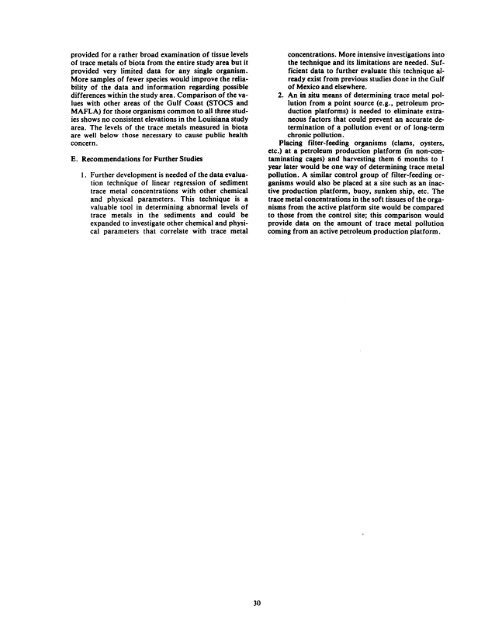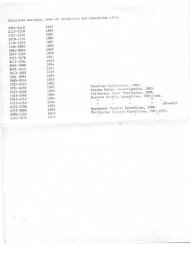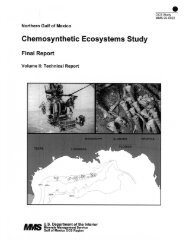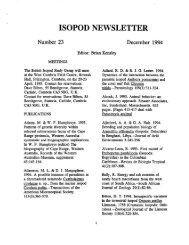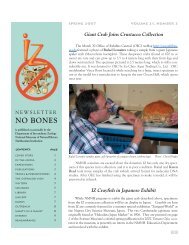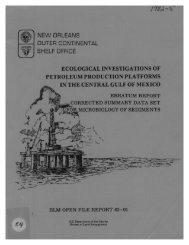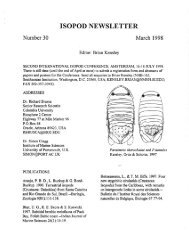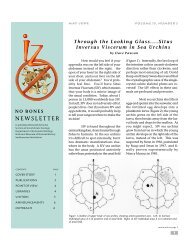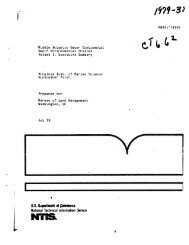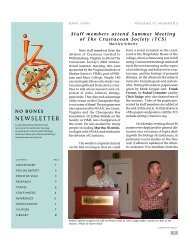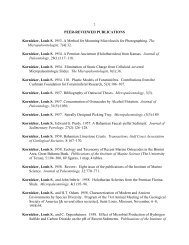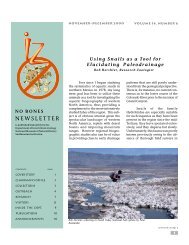Vol.1 part 4-5 - Department of Invertebrate Zoology
Vol.1 part 4-5 - Department of Invertebrate Zoology
Vol.1 part 4-5 - Department of Invertebrate Zoology
You also want an ePaper? Increase the reach of your titles
YUMPU automatically turns print PDFs into web optimized ePapers that Google loves.
provided for a rather broad examination <strong>of</strong> tissue levels<br />
<strong>of</strong> trace metals <strong>of</strong> biota from the entire study area but it<br />
provided very limited data for any single organism .<br />
More samples <strong>of</strong> fewer species would improve the reliability<br />
<strong>of</strong> the data and information regarding possible<br />
differences within the study area . Comparison <strong>of</strong> the values<br />
with other areas <strong>of</strong> the Gulf Coast (STOCS and<br />
MAFLA) for those organisms common to all three studies<br />
shows no consistent elevations in the Louisiana study<br />
area . The levels <strong>of</strong> the trace metals measured in biota<br />
are well below those necessary to cause public health<br />
concern .<br />
E. Recommendations for Further Studies<br />
Further development is needed <strong>of</strong> the data evaluation<br />
technique <strong>of</strong> linear regression <strong>of</strong> sediment<br />
trace metal concentrations with other chemical<br />
and physical parameters . This technique is a<br />
valuable tool in determining abnormal levels <strong>of</strong><br />
trace metals in the sediments and could be<br />
expanded to investigate other chemical and physical<br />
parameters that correlate with trace metal<br />
concentrations . More intensive investigations into<br />
the technique and its limitations are needed . Sufficient<br />
data to further evaluate this technique already<br />
exist from previous studies done in the Gulf<br />
<strong>of</strong> Mexico and elsewhere .<br />
2 . An in situ means <strong>of</strong> determining trace metal pollution<br />
from a point source (e.g ., petroleum production<br />
platforms) is needed to eliminate extraneous<br />
factors that could prevent an accurate determination<br />
<strong>of</strong> a pollution event or <strong>of</strong> long-term<br />
chronic pollution .<br />
Placing filter-feeding organisms (clams, oysters,<br />
etc .) at a petroleum production platform (in non-contaminating<br />
cages) and harvesting them 6 months to 1<br />
year later would be one way <strong>of</strong> determining trace metal<br />
pollution . A similar control group <strong>of</strong> filter-feeding organisms<br />
would also be placed at a site such as an inactive<br />
production platform, buoy, sunken ship, etc . The<br />
trace metal concentrations in the s<strong>of</strong>t tissues <strong>of</strong> the organisms<br />
from the active platform site would be compared<br />
to those from the control site ; this comparison would<br />
provide data on the amount <strong>of</strong> trace metal pollution<br />
coming from an active petroleum production platform .<br />
30


